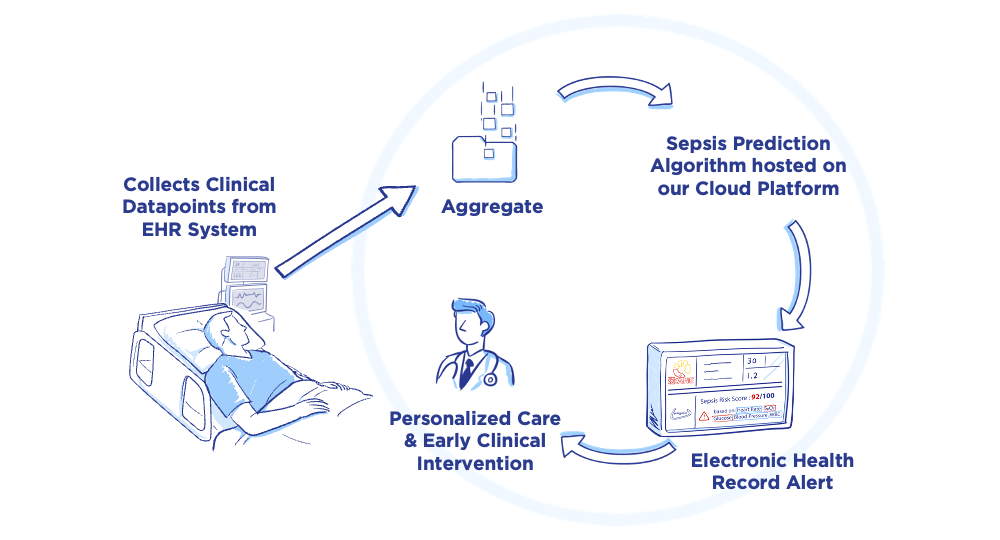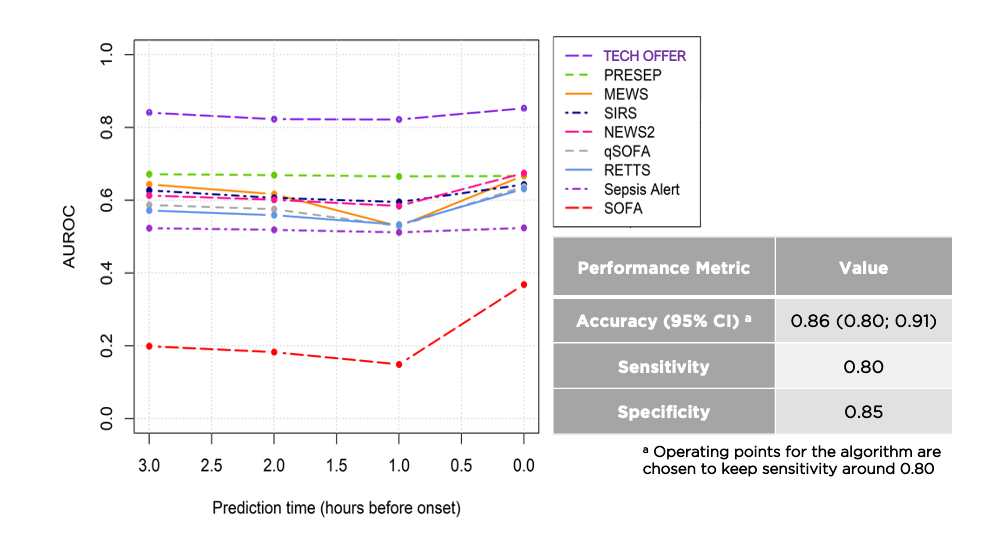Technologies
Discover, Connect & Collaborate at TECHINNOVATION 2021
Sepsis Prediction Algorithm For Intensive Care
Technology Overview
Sepsis is a severe life-threatening clinical syndrome caused by the dysregulated host response to infection. Annually, it affects 49 million people and accounts for 35% of hospital deaths. Despite being a potentially fatal condition, early intervention with antibiotics, fluid resuscitation, source control, and support of vital organ function have shown to dramatically improve patient outcomes. However, without any existing reliable biomarkers, early recognition of sepsis is a challenge. Recognition is further complicated by its syndromic nature and heterogeneity of the host response to infection. Although sepsis care bundles exist to guide rapid intervention upon sepsis recognition, early diagnosis or even prediction is vital in managing sepsis and patient outcome.
This technology offers a machine learning algorithm for autonomous sepsis prediction of intensive care unit (ICU) patients. It predicts sepsis onset in adult ICU patients up to 3 hours in advance, using clinical datapoints routinely collected in the ICUs. As a clinical decision support tool, sepsis prediction scores are calculated continuously and autonomously, alerting clinicians to patients at risk of sepsis development. The algorithm empowers clinicians to deliver personalized care and early clinical intervention. The aim is to improve patient outcomes and reduce healthcare costs by providing accurate prediction, diagnosis, and treatment support.
We are seeking partnerships with Electronic Healthcare Record (EHR) providers and healthcare organizations to integrate and test-bed the sepsis prediction algorithm. Other business opportunities and collaborative development of other disease prediction algorithms in intensive care (e.g. acute kidney injury, decompensation, cardiac arrest) are open to discussion as well.
Technology Features, Specifications and Advantages
The gold standard for sepsis diagnosis is Sepsis-3, a scoring system that combines information from clinical examinations, monitoring devices and laboratory data. However, clinicians are required to manually and in a continuous manner tabulate the information for diagnosis. Its accuracy is also dependent on the clinician’s skills and experience. This risks delay of time to diagnosis and initiation of treatment.
This technology is the first sepsis prediction algorithm regulatory approved for commercial use in Europe. It predicts sepsis onset in adult ICU patients up to 3 hours in advance before it can be detected with Sepsis-3. Hosted on our cloud platform, compliant with GDPR and ISO 27001 requirements, the algorithm integrates with EHR systems and measurement devices to collect the common clinical datapoints for prediction, alleviating the need for dedicated examinations and manual tabulation. With a total accuracy of 86%, the algorithm alerts clinicians to patients at risk of sepsis development for immediate care and early clinical intervention. This greatly reduces the time until first clinical intervention, length of stay and healthcare costs incurred by the patients and hospitals.
Currently, the algorithm is going through a prospective clinical trial with a major Swedish hospital, which will be completed by the end of September 2021. This is the largest randomized clinical trial ever conducted with a sepsis prediction algorithm, with over 300 adult ICU patients enrolled. In partnership with a leading EHR provider, the algorithm will also be undergoing a prospective multi-centre study with over 1,000 adult ICU patients enrolled.
Potential Applications
The sepsis prediction algorithm is a proprietary Software as a Medical Device capable of integration with EHR systems and measurement devices in the ICU wards. Potentially, it can change the way sepsis is managed in hospitals and reduce the rate of sepsis development in ICU patients.
Not only can the algorithm be trained on local patients to maximize model accuracy and clinical value, but it can also be trained to predict sepsis in different clinical settings such as the emergency departments and general wards. With the underlying technology and know-how from the sepsis prediction algorithm, other disease prediction algorithms can be developed as well.
The global clinical healthcare analytics market is projected to reach $11 billion USD by 2025 with a CAGR of 24%. The market is currently dominated by North America, but the Asia-Pacific region is expected to grow at the fastest rate as governments of the emerging economies of India and China have been investing heavily in the development of big data infrastructure and applications. Major factors responsible for the global growth include government initiatives to increase EHR adoption, growing pressure to curb healthcare spending and improve patient outcomes, the emergence of big data in healthcare, and the rising importance of real-world evidence.
Customer Benefit
Clinical benefits
- Enhances patient monitoring, earlier detection of sepsis, and improves patient outcomes
- Empowers clinicians to deliver personalized care and early clinical intervention for sepsis management
- Reduces the time until first antibiotics treatment and cultures conducted
- Decreases the sepsis mortality rate by 7.6% with every hour of early diagnosis and treatment
- Shortens the average ICU length of stay by 0.5 days by predicting sepsis onset up to 3 hours in advance
- Reduces patient’s readmission rate, and improve their quality of life and life expectancy in the long term
Economic benefits
- Lowers healthcare costs incurred by both the patients and hospitals
- Supports the ease of adoption and integration into existing clinical workflows as the algorithm uses clinical datapoints routinely collected in the ICUs and therefore, does not require any dedicated examinations and manual tabulations
- Ensures timely and accurate predictions while alleviating the typical expenses and complexity of on-site hardware with on-cloud deployment

